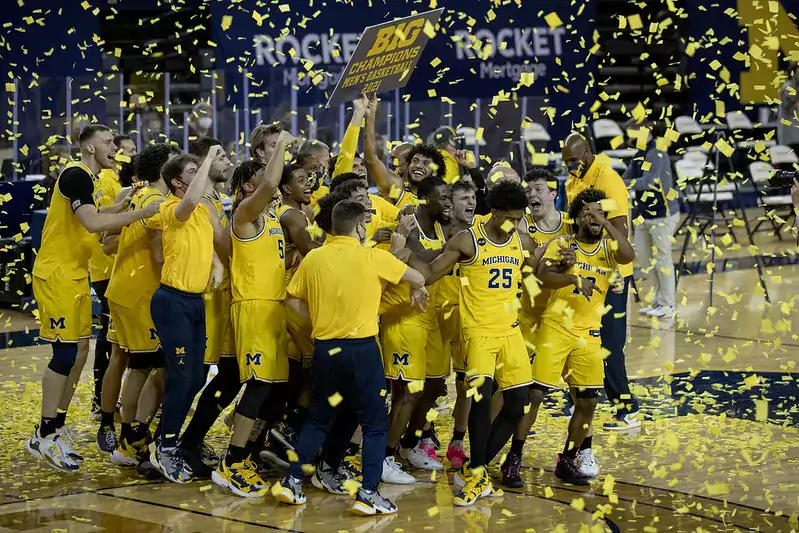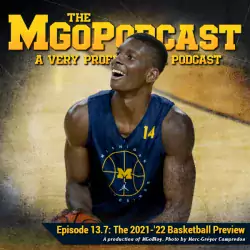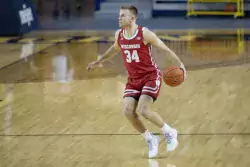2021-22 basketball preview

The Sponsors
Thank you to Underground Printing for making this all possible. UGP makes custom apparel such as t-shirts and sweatshirts and was founded by 2 Michigan alums over 20 years ago. They have 3 retail locations in Ann Arbor and offer thousands of University of Michigan athletic products for sale, ranging from clothing to accessories and memorabilia. Check them out at ugpmichiganapparel.com.
And let’s not forget our associate sponsors: Peak Wealth Management, HomeSure Lending, Ann Arbor Elder Law, Michigan Law Grad, Human Element, The Phil Klein Insurance Group, Prentice4M, and introducing Team Fan Club! We are of course made possible by SignalWire.
THE VIDEO
[After THE JUMP: the player and what we said]

Now that we have finished the roster section of this season preview, we get into the last installment: our annual 5 Questions, 5 Answers piece. Throughout the preview's other pieces, I hinted at some of the answers listed in this article but didn't have the opportunity to properly spell them out. Now I do. So here we will tackle those questions head on, looking at the rotation, how the team's macro units (offense and defense) shape up, and the schedule:
1. What’s the minutes rotation going to look like?
This answer isn’t purely based on my intuition but is also influenced by the insider nuggets that have been leaking out of practice, in addition to what we learned at the exhibition. The exhibition starting lineup matched what we'd been hearing from practice:
D. Jones – Brooks – Houstan – Johns Jr. – Dickinson
The second team, for the most part, matched what we'd been hearing, with Bufkin, Terrance Williams, and Diabate all playing significant roles off the bench. The part that surprised me was seeing 13 minutes for Adrien Nuñez, but it remains to be seen how much of that was related to the injuries to Frankie Collins and Zeb Jackson, two direct competitors for Nuñez's minutes who are apparently banged up right now. My conjecture remains very skeptical on Nuñez's chance of sticking in the rotation based on how every other attempt to put him in the rotation in his NCAA career has ended, so I still see the second team looking like this:
Collins – Bufkin – Z. Jackson – T. Williams – Diabate
This second team may take until the second half of the season to really materialize (especially at the guard position) since freshman are listed at a number of spots. With that in mind, I think this is a rough sketch of the minutes rotation, based on what I’ve assigned to each player as their “role” during each positional preview:
- PG: Jones 30 minutes, Brooks 5 minutes, Collins 5 minutes
- SG: Brooks 28 minutes, Bufkin 10 minutes, Jackson 2 minutes
- SF: Houstan 25 minutes, Williams 10 minutes, Jackson 5 minutes
- PF: Johns Jr. 25 minutes, Diabate 5-8 minutes, Williams 5-10 minutes
- C: Dickinson 25-30 minutes, Diabate 10-15 minutes
It is very possible that Houstan could inch closer to 30 minutes as the season goes along if he’s playing well. Similarly, it’s possible that Bufkin and Collins may not hit their projection early in the season but grow into it as the year comes along. Diabate may spend more time at the PF position next to Dickinson if the two show they can execute at a high level on both ends of the court next to each other. It’s an intriguing possibility of running the two twin towers out there, but we have to see it click first before getting too high on it. Lastly, Zeb Jackson's role listed here is pretty minor and it wouldn't be hard to see him getting squeezed out when it's time to tighten the bench in March. The same could be said for Collins if he has a rough first season like many young B1G PGs do.
The player whose projection I feel most sure about outside of the projected starters is Terrance Williams II. I have him slated for 15-20 minutes between the SF and PF position and I am reasonably confident in that. Juwan loves T-Will and if he has indeed made significant improvements to his game— including an operational three-point shot— I think he’s the team’s sixth man, a la Chaundee Brown last season, getting time at multiple positions and possibly closing games out because of his defensive intensity and motor.
[AFTER THE JUMP: Offense, Defense, and Schedule!]

2021-22 B1G Basketball Season Preview... previously: Season preview podcast, Power Rankings Lower Half, Power Rankings Upper Half, Guards, Wings
This piece is the last in our series of roster previews, following the guards and wings, which we have already covered previously. Again, the positional designations are decently flexible so the players discussed in this article may play other positions besides the 4/5, but we had to split up the roster into three fragments, and this was the best way to do it. There are four players discussed in this piece, and we start with the big(gest) man first:
Hunter Dickinson
Year: Sophomore
Height/Weight: 7’1”/260
Key Counting Stats: 26.0 MPG, 14.1 PPG, 7.4 RPG, 0.9 APG, 1.4 BPG, .598/.000/.739
Key Advanced Stats: 26.4% usage, 111.0 ORtg, 10.9 OR%, 21.3 DR%, 19.7 TORate, 7.3 Assist rate, 42.5 FTRate, 5.4 Blk%
Dickinson’s freshman season could very well get its own post to chronicle the many twists and turns it contained. You might not remember it well, but HD entered the 2020-21 season on the bench, with real questions about his ability to hang with high level stretch bigs defensively, and how quickly he could move past Austin Davis on the depth chart. The first game was pretty nondescript, but after Dickinson posted 19 points on 6/8 from the floor with four assists in just 25 minutes against Oakland, it was clear that the freshman’s moment as the starting center was coming very soon.
From there Dickinson was Reserve In Name Only for a few games, coming off the bench to begin the contest but getting more minutes than Davis. Then Big Country suffered a plantar fascia injury and Dickinson became the starter and never looked back. Dickinson charged into Big Ten play and was an absolute menace, hanging 26 on Maryland in a New Year’s Eve showcase and then putting up 28 on Minnesota only a couple games later. Good memories:
At this juncture, Dickinson seemed unstoppable. He was shooting an outrageous 73% on his twos, dominating in post ups with his signature lefty hook, crushing the rim as the roll man in the PNR, and using his passing ability to have the game flow through him. It made you wonder “it can’t be this easy, can it?”. Well, if you wondered that, the answer was no, it can’t be this easy.
In his next game out against Wisconsin, Dickinson suddenly saw aggressive double teams from the opponent, who resolved that giving Dickinson no chance to score was the best strategy. It didn't work out so well for the opponents: though HD posted only 8.8 PPG over the next six contests, Michigan kept winning, because his passing allowed Michigan’s deadly three-point gunners to get hordes of uncontested threes. It looked like this:
Dickinson cutting down on the turnovers was a notable development in his game during this period, but it was his defensive growth that most often earned lavish praise from this website. He held Luka Garza, seemingly the kind of big who the athletically-limited Dickinson was doomed to fail against, to 16 points on 6/19 from the field in late February, and then had another great defensive outing against another tricky high-usage big in Trayce Jackson-Davis of Indiana a few days later.
The final stretch of the season was rocky. Frustrating fouls became a story in a dismal offensive showing against Illinois’ Kofi Cockburn and in the second outing against Michigan State as Michigan’s late regular season push fizzled. Dickinson was better in the final five contests comprising the Big Ten Tournament and the NCAA’s, but his offensive numbers declined significantly in the latter half of the season overall.
Despite the challenges that Dickinson encountered after his initial surge, the totality of the season is still pretty spectacular, especially for a freshman in a conference with so many talented post-up bigs. Dickinson posted a 111 ORtg (5th in the conference among high usage players) on 26.4% usage, Michigan’s highest usage player by a significant margin. He finished the season shooting 59.8% from the field and 60.7% from two.
Inside the paint, Dickinson was a menace: he attempted 59.4% of his shots at the rim and shot 74.2% on those shots. His 83.3% FG% on putbacks at the rim were in the 91st percentile, per Synergy. Even outside the paint, Dickinson’s post up ability was lethal, 1.03 PPP on post ups, ranking in the 86th percentile in that metric. His passing ability can break down defenses who decide to double him, and it allows him to be used heavily in Horns sets away from the basket.
And unlike Luka Garza, it wasn’t just all offense. Dickinson was a plus defender, a talented rim protector who was surprisingly switchable on smaller opponents, showcasing that most memorably against D’Mtrik Trice of Wisconsin in February:
In totality you have a destructive offensive player who surpassed expectations defensively and helped Michigan win a B1G title and snare a #1 seed in the NCAA Tournament. That resume landed him 8th in KenPom’s National Player of the Year rankings and makes Dickinson an easy bet to be an All-American as a sophomore. But what does Dickinson need to do to go from a player of the year contender to the player of the year favorite?
To me there are three wild cards that could raise the ceiling of an already immensely successful collegiate player. First, Dickinson needs to be able to post up with the right hand. Dickinson’s reliance on the left hand was at the top of every team’s scouting report on the 7-1 big man by midway through the year, and sooner or later, opponents started sitting on it. The numbers back it up.
Per Synergy, Dickinson turned the left shoulder (meaning he shot with his right hand) on post ups only 5-20% of the time depending on where he was on the court, contrasted with turning the right shoulder between 50 and 70% of the time. That’s a massive disparity, the kind that shows up on scouting reports and causes strategic adjustments, which of course is what happened. Dickinson developing an operational hook with the right hand will, at the very least, remove that bullet from the scouting report and make him an even more difficult player to guard in the post.
Secondly, it remains to be seen how much more physically conditioned Dickinson got over the summer. Michigan has seen considerable athletic/physical leaps from players in the past after they spend a summer with famed strength/conditioning coach Jon Sanderson. While it’s unlikely that a summer at Camp Sanderson will turn Hunter Dickinson into a Bo Jackson-caliber athlete, slapping a little more muscle on his frame could prove useful when going up against the mountain of meat that is Kofi Cockburn. Similarly, slightly improved agility could make Dickinson a bit more dangerous off the dribble and as a defender in space. A big jump in athleticism and physique are not probable for an already old(ish) player like Dickinson (he turns 21 in November) who came into college reasonably developed, but improvements on the margin could pay dividends in big moments.
Third, the big black box of uncertainty is the possibility of Dickinson adding a three-point shot. He attempted a grand total of four threes last season and went o-fer on those shots. We know from anecdotal practice footage and reports that HD has been working on his three-point shot in the offseason, so we’ll see what it looks like to begin the season. Matt D noted when Hunter was a prospect that he had a developing three pointer in his repertoire as a senior in HS, but that mostly went back in the garage last season. Now Dickinson will show how far it has come. My gut tells me it will be like the Teske three-point shot; a gadget play that never really becomes a weapon (Dickinson shot only 40.2% on two-point jumpers last season per Synergy), but I will be happy if I’m proven wrong.
Role: This is the Hunter Dickinson Show now. He came back to school to be The Guy in Ann Arbor, even though he was already Michigan’s highest usage piece last year. Dickinson’s fightin’ words (particularly towards Illinois) are already one of the B1G’s biggest storylines entering this season and watching the clips of Michigan Madness, it’s pretty clear that HD loves his starring role in the spotlight. He’s going to play ~30 minutes per game and may even see his usage tick up slightly, and Michigan’s offense will revolve around him. This is your starting center and an easy bet for 1st team All-B1G + a strong contender for B1G POY. Dickinson’s already a great player… but how much better can he get?
[AFTER THE JUMP: lots of talent and a small-town Minnesota boy]

Lotta unfamiliar faces

Veterans and young'uns in the backcourt

The B1G teams you actually want to read about

The (less good) enemy

Castleton has been running for like 12 years. Nathan Fillion is also on that show.

starting with an apology to the reader but not to northwestern basketball

finally ranking them this time

watch your nuts!

michigan and mike woodson are winning a wild offseason so far

2